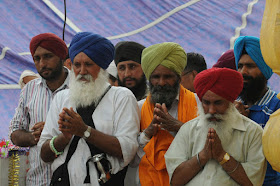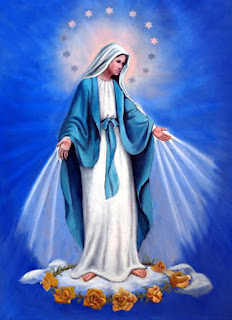When people join my campaign they are often surprised by just how darn much religion there is. When I play other places I am shocked how little religion there is. I think there is something anyone doing any world building needs to really, really needs to understand and that is - the relative lack of public religion in contemporary America is, historically speaking, really freakin' weird.
"But, Rick!, " I hear you say, "In America religion is everywhere! You are obviously wrong."
Dream on, sucker. Let me show you some things.
Another objection is 'But RPGs are about worlds where Gods are real and have a direct impact on the world'. Well, guess what? Most religious people are certain God is real and has a direct impact on the world. In other worlds, throughout history and much of the contemporary world people are just as certain in God and such as any NPC in your game. We can make a better/richer/more realistic/more gripping fictional world by examining the Real World.
In real life through history religion is a rather big deal and very, very public. Although I will be focusing on Europe I will point to other places, too.
Let's start by talking about processions. Processions are religious events that involve religious leaders and followers doing what is essentially a parade in public. Here is an article about a good Friday procession from Brooklyn to Manhattan. Here is a video from a procession about a half century ago;
People wear special clothes, carry banners and floats, etc. There are a fair number of Processions in Catholic and Anglican observances. One of my favorites are the Rogation processions, which are usually done twice in the Spring (but rarely only once). In rural parishes these processions involved blessing the fields, in urban ones a blessing of the streets. If there were two one of them usually included something called 'beating the bounds' when the borders of the parish (and the limits of the local priest's direct personal authority) were the route of the procession. Rogation processions looked like this;
You can see the difference between a rural parish and a town parish. But what did an urban procession look like? Like Spain:
You will see people dressed like this
No, that has nothing to do with the American KKK; the face is covered to prevent the person from being recognized and gaining acclaim for being in the procession. The pointed hat, a capirote, is meant to look ridiculous so that the member will be humble, not prideful.
Again, anonymity means that the procession is done not for personal glory.
Again, these women dress identically to avoid standing out.
These societies that build and maintain the floats and process together are very old, older than many countries, and some are largely hereditary. Sometimes they are merely a group of religious people; sometimes they are also a drinking club; occasionally they are like a fraternity where members pledge to help each other.
And Catholics aren't alone! You also have:
Buddhists
Hindu
Muslim (the best pic I could find, but they can be rather large)
Shinto
And Sikh.
In other words, religions have parades. Plenty of them. In an area of homogenous religion, like Catholic Europe or similar, you might have days where everyone, and I mean everyone who isn't absolutely critical, crippled, or caring for newborns, is in processions! In areas of heterogenous religions, like India or the like, you might have various processions going on almost all the time with Sikhs, Hindus, Muslim, and Catholics walking down the street almost every month, or more.
Sometimes these different processions are just fun to watch and can even forge bonds between neighbors of different religions. Sometimes, though, religious processions can be the trigger for violence. While this is not a political blog so I will not comment on (and will delete comments about) real world politics, religious processions and such can lead to violence.
Violence stemming from religious processions occurs all over the world, at various times.
Since such things are surprisingly common in the real world, consider adding them to your world/campaign.
Another thing to think about is the distinctive dress of religious people. Lots and lots of religions have distinctive dress, jewelry, etc. Sometimes religious dress is for all believers and is very distinctive;
As with Sikhs
And some Jews
Sometimes it is universal but more subdued,
Which can include markings like the bindi
And the Mormon temple garment, usually concealed by outer clothing, but sometimes visible.
It can also be jewelry;
Such as the Catholic medals and scapulars.
Sometimes religious dress is restricted to people in religious roles, such as,
Buddhist monks and nuns and the example most common in Europe,
Catholic priests, nuns, and monks.
Indeed, with some experience (such as growing up in the culture) a single glance at a priest, nun, or monk can often tell you exactly which religious order they belong to, their general duties, and their rank within the organization.
Another thing to think about is religious festivals. The impact of religious festivals is greater than you might think; they can dictate the pace of the calendar, the crops, the economy, and politics.
The observance of religious festivals and a liturgical calendar (the calendar of a particular religion) can really impact culture and commerce. In the Real World in the Medieval period all Catholics that did not have critical duties attended Mass every Sunday and did not eat meat other than fish on Fridays. There were up to 23 more days other than Sunday with mandatory Mass attendance and between 90 and 100 days other than Fridays that required the removal of meat other than fish from the diet. Think about just this one fact - for almost half of the days of the year Medieval Catholics ate no beef, chicken, pork, mutton, or game! The result was flourishing fish markets even inland and a taste for eel in the diet.
When differing religions with different restrictions and days live close to each other very interesting interactions occur. Medieval jews were sharply restricted in the sorts of work they could do on their Sabbath (sunset Friday to sunset Saturday) while neighboring Catholics were not. Likewise, Catholic were limited in the work they could do on Sundays (technically from sunset Saturday to sunset Sunday)
(Yes, really - why do you think contemporary Americans can go to Sunday Mass Saturday night? Liturgically, it is Sunday! See how interesting liturgical calendars can get?)so some jews had what was called a Shabbas Goy - non Jews who performed certain tasks on Saturdays and some Catholics hired Jews to perform labor on Sundays.
The Hindu festival of Karva Chauth is a day where women fast from sunrise to moonrise. During this time they join with other women to sing songs, recite prayers, and enjoy each others' company. At moonrise they perform a ritual and then receive their first food and water of the day from their husbands. The festival is focused on the women praying for the health and happiness of their husbands. It is traditional for the husband to thank his wife by the giving of gifts to her at the end of the day, especially fine clothing and jewelry and they sometimes join in the fast. The sale of specific garments and gifts as 'Karva Chauth gifts for your wife' is pretty old and the regions that celebrated it would see merchants coming a month before to take advantage of it. The festival is spreading in popularity to the point that modern merchants incorporate Karva Chauth in ads for SUVs!
Why did the Spartans only send 300 men into battle? It was during a religious festival and that was the most they could send because of their religious restrictions.
Medieval European trade fairs were often originally focused on the feast days of the Patron Saints of the towns hosting the fairs. Certain dyes or cloth were more valuable in specific areas because of the religious requirements on dress and ornamentation found there. The contemporary wedding industry is very, very busy in June because traditionally that wa the earliest month of the year a bride could be certain her wedding would not clash with a Catholic feast day that required fasting (bet you didn't know that!). And until the wedding of Queen Victoria most wedding dresses in Europe were blue, not white. Why blue?
That's why. Religion is also why the names Mary, Fatima, Paul, etc. are some of the most-used in history.
One of the most dramatic events of WWI occurred around Christmas in 1914 when many troops simply refused to fight around the holiday. Soldiers decorated their trenches with lights and Christmas trees, sang carols to the opposing sides and in the morning met in No Man's Land to exchange gifts, share liquor and tobacco, send letters to friends and relatives in other nations, and celebrate a holiday. While not universal it happened on both fronts between virtually all nationalities.
It would have happened again at Easter and following Christmases but the generals forbade it under the threat of serious punishments.
I could go on about St. Crispin's Day and the reason why birthdays are new but celebrating birthdays isn't, but I think you get the idea. In Real Life religion impacts virtually everything you do in private and in public. So when you are working on that pantheon and that religion for your new world, don't forget!
Processions
Dress
Restrictions
Festivals
Calendars
They matter.






























I guess there are two reasons why religion is not really important in D&D. You have mentioned one: our modern society does not take mysticism as seriously as it used to do. We are too tolerant to accept that other people have different faith, and that work as well for them as it does for us. People also live quite well not believing in any deity. Religion has become a point of identity, rather than a point of cosmological order. I guess, it would be very challenging to play a fantasy game, if you are a religious fanatic, who accepts only a single Reality.
ReplyDeleteThe second point why religion does not matter in D&D is because there is no game structure (rules) for the players to interact with the divine. Clerics and paladins may have a god name written on the character sheet, but their actions are not normally punished or compensated for acting in certain way or another. Players don't enjoy when the DM rules out about their character behaviour or morality. The game lacks a rule mechanism for making the players engage in religious activities. What kind of benefit does the character get by joining the procession? What kind of benefit does the character get by offering a sacrifice, or by paying a tithe from the treasure they've got from the dungeon? If the characters represent a god, or a pantheon, how would other gods interact with the PCs? How would they get protection, or lose protection? I am not too sure about how to implement a game structure for those things yet, but I think it is important. Perhaps a luck system?
https://harbingergames.blogspot.com/2015/08/religion-in-my-ad-1e-campaign.html?m=1
Delete